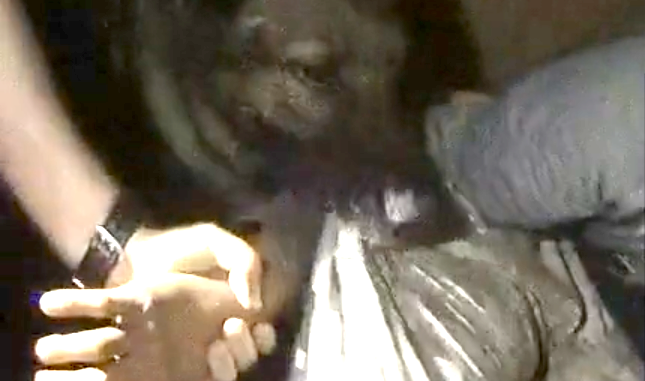
To view the dog attack, here’s the video Palo Alto police released. And here’s a link to the eight videos Mountain View police released.
Correction: A previous version of this story mischaracterized the remarks of attorney Sarah Marinho. This version has been corrected to accurately reflect her views.
BY KYLE MARTIN
Daily Post Staff Writer
An attorney who is representing a victim of a police dog attack in San Jose said she is concerned after watching body-cam videos of a Palo Alto police dog attacking a man in his Mountain View backyard.
Attorney Sarah Marinho emphasized that all she knows about the police dog attack of Joel Domingo Alejo is what she’s seen on the videos, but she said the episode raises questions.
The video shows Palo Alto Police Agent Nick Enberg repeatedly telling the dog to bite Alejo although Alejo wasn’t resisting the officer.
“What are the other officers doing?” attorney Marinho asked.
The incident occurred in Mountain View on June 25, and a Palo Alto police agent, Nick Enberg, and his dog were asked to help the Mountain View officers search for the kidnapper. After the dog repeatedly bit Alejo, officers discovered he wasn’t the kidnapper.
Alejo’s attorney has filed $20 million claims against each city.
Marinho is currently litigating another police dog attack in San Jose.
Marinho told the Post she does not support the police use of dogs to bite people. And she said that a jury may find Enberg not have been justified with using the dog to bite Alejo. Moreover, if the jury finds that the use of a dog to bite Alejo was justified, it’s up to police to prove that the continued biting was not an excessive use of force.
“That was far too long. The dog should instantly give up if it’s properly trained,” Marinho said. “If they’re properly trained and fit to do this, they’re supposed to release when commanded.”
According to Palo Alto’s police policies, a police dog can be used if “there is a reasonable belief the suspect poses an imminent threat of violence or serious harm to the public, any officer or the handler,” if the suspect is resisting or threatening to resist arrest and if the suspect is “believed to be concealed in an area where entry by other than the canine would pose a threat to the safety of officers or the public.”
Marinho noted that the footage released by Palo Alto is edited and does not show the full story of what happened before, during and after the Alejo attack.
Palo Alto officials said they had edited the footage released to the public. The Post, which requested the video under a state law that requires its release, is seeking the unedited video.
Marinho she said more footage might show that the other responding officers at the scene may have had an obligation to stop Enberg from inflicting too much damage on Alejo.
In San Jose, Marinho said canines are “not just for anyone or any situation.”
“It has to be a dangerous situation where that person is taking someone hostage or is armed, such to where an officer would get shot if he goes in,” Marinho said. “The police’s mandate is to safely bring their suspect into custody.”
Councilman Greer Stone, who previously served on the city’s Human Relations Commission and the commission’s Justice Review Committee, told the Post the attack provides an opportunity for the city to review its police policies for possible changes in the future.
Stone said he watched the video on March 15 of a Palo Alto video of the attack before the city released the footage to the Post and the public.
Later that day, the council had its first discussion of the June attack. The discussion was behind closed doors. A closed-door meeting is allowed if it involves litigation against the city.
While he declined to comment much on the case, which council first discussed in closed session on March 15, Stone said the city with the Palo Alto police department and other community members should review policies such as use of canines sometime this year.
“Having seen the video, it was clearly a terrible incident. I feel terrible for Mr. Alejo to be on the receiving end of that dog attack,” Stone said. “I can’t imagine what that would be like to wake up in a backyard that you are allowed to be in and have a police dog on his leg and police officers confronting you. That’s horrifying, and I’m glad he’s OK and he’s recovering.”
Stone added that “any time you’re dealing with a trained police canine, the damages could always be far worse.”
“There are clearly moments where canines are beneficial for the police department in order to conduct searches and keep the community safe,” Stone said. “I think there’s a balance to be struck and I think we should explore that.”
Previous Post stories on the Alejo attack
• March 28, NAACP calls for firing of cop in dog-bite case
• March 22, Residents call for cop’s firing in dog attack
• March 16, Police release video of dog attack
• March 15, City Council to discuss police dog attack behind closed doors
• Jan. 28, Police dog attacks innocent man napping in his own backyard



